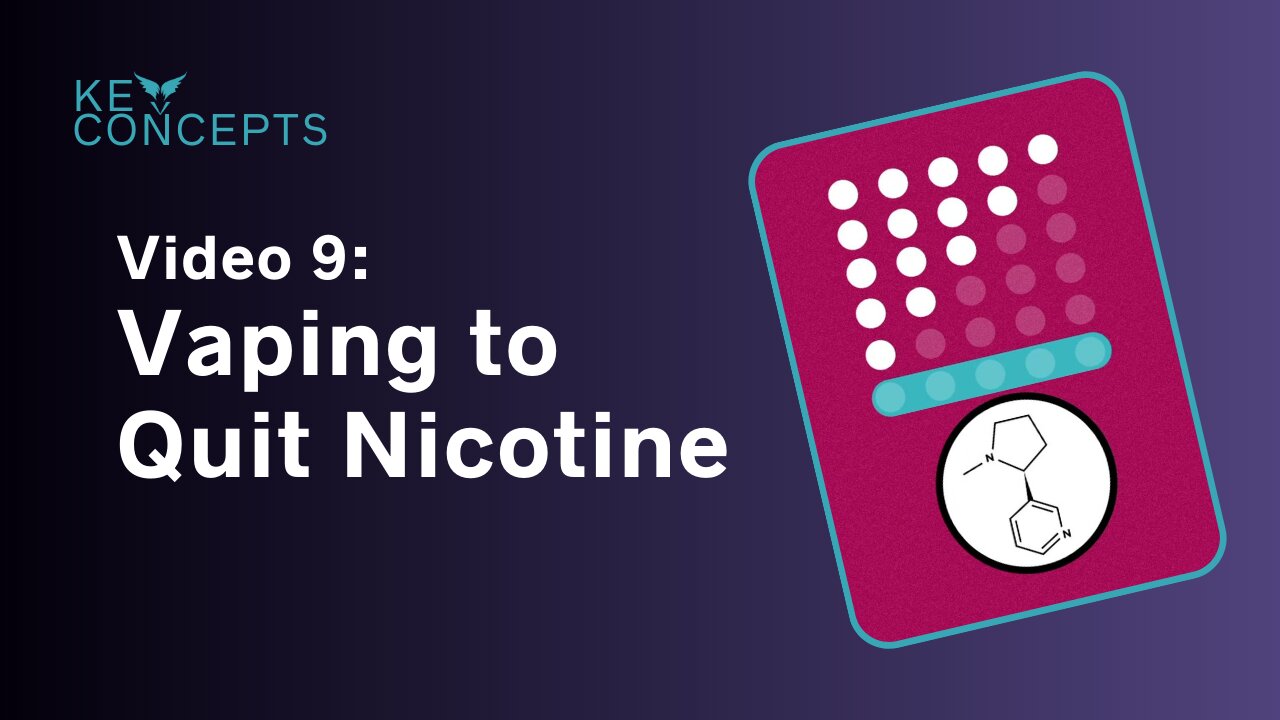Premium Only Content

VAEP Key Concepts Video 9: Vaping to Quit Nicotine
Did you know that vaping can be used to stop smoking AND wean off nicotine in just 4 stages?(1)
In the first stage, the smoker dual uses which means they continue to smoke, while they get the hang of vaping. Some “experts” claim that vaping is ineffective for quitting smoking because many dual use for a while.(2) Dual users observed in controlled clinical trials reduce the number of cigarettes they smoke by 60-80%.(3) This significantly reduces the toxins they inhale.
The second stage is when they stop smoking and vape exclusively.(1) At this second stage, they have dropped virtually all the toxins found in smoke and reduced their risk to less than 5% of smoking.(4) That is why vaping is harm reduction.
The third stage is to reduce the strength of nicotine they are vaping.(1) Eliquid that goes into a vape comes in varying concentrations of nicotine. You can’t get that with cigarettes! Once the vaper has lowered their nicotine to a very small dose, they can vape eliquid without nicotine. The vaper still has the satisfaction of the behaviour while they get used to no nicotine. It’s interesting to note that the government of British Columbia, Canada has made eliquid without nicotine illegal, making this step unavailable to their citizens.(5) Crazy, eh?
The fourth and final stage is to stop vaping nicotine-free eliquid and since there is no nicotine dependance, this can be pretty easy.(1) So, that is how vaping helps smokers get off of nicotine.
“Since 2016, our nonprofit, Vaping Advocacy and Education Project, better known as VAEP, has been reviewing the scientific evidence on vaping and making it easy for people to understand. Visit VAEP.info for vape info.” https://VAEP.info
************
Kellie Ann is wearing our Sweetheart tee in heather purple https://shop.vaep.info/?product=vaep-sweetheart-tee
************
References
1. Laugesen, M. (2013). Nicotine and health. New York, NY: American Council on Science and Health https://uwspace.uwaterloo.ca/bitstream/handle/10012/12188/Czoli_Christine.pdf?sequence=3
2. Czoli, C.D. (2017). Patterns of use and biomarkers of exposure among ‘dual’ tobacco cigarette and electronic cigarette users in Canada. University of Waterloo. https://uwspace.uwaterloo.ca/bitstream/handle/10012/12188/Czoli_Christine.pdf?sequence=3
3. Polosa, R., Caponnetto, P., Maglia, M., Morjaria, J. B., & Russo, C. (2014). Success rates with nicotine personal vaporizers: a prospective 6-month pilot study of smokers not intending to quit. BMC Public Health, 14(1), 1159. https://pubmed.ncbi.nlm.nih.gov/25380748/
4. British Medical Journal. (2018). Public Health England insists e-cigarettes are 95% safer than smoking. https://www.bmj.com/content/363/bmj.k5429
5. Government of British Columbia. (2020). Public Health Act: E-substances Regulation. B.C. Reg 186/2020. https://www.bclaws.gov.bc.ca/civix/document/id/complete/statreg/186_2020#section4
Original music provided by WiesingerMusic.com
#VAEPinfo #VAEP #VEAPworld #vaping #vape #vapefam #TalkAboutVaping #DoTheVapeTalk #KeyConcepts #HarmReduction
-
 2:33:58
2:33:58
TimcastIRL
6 hours agoDan Bongino ACCEPTS Deputy FBI Director, SECRET NSA CHATS EXPOSED w/Joey Mannarino | Timcast IRL
123K65 -
 1:09:33
1:09:33
Glenn Greenwald
10 hours agoMichael Tracey Reports from CPAC: Exclusive Interviews with Liz Truss, Steve Bannon & More | SYSTEM UPDATE #412
82.2K69 -
 56:02
56:02
Sarah Westall
7 hours agoBiohacking & Peptides: Weight loss, Anti-Aging & Performance – Myth vs Reality w/ Dr. Diane Kazer
33.2K14 -
 11:22
11:22
Bearing
17 hours ago"Anxious & Confused" Federal Workers FREAK OUT Over DOGE Efficiency Email 💥
38.5K60 -
 1:31:20
1:31:20
Flyover Conservatives
1 day agoUS STOCK MARKET: Sinking Ship - Dr. Kirk Elliott; How I Fought Back Against Woke Schools & Stopped Gender Bathrooms - Stacy Washington | FOC Show
51.3K1 -
 1:08:09
1:08:09
Donald Trump Jr.
11 hours agoFBI Dream Team, Plus Taking Your Questions Live! | Triggered Ep.219
189K252 -
 7:32:37
7:32:37
Akademiks
11 hours agoDrake and PartyNextDoor '$$$4U' Album Sells 250K first week. BIG AK IS BACK.
110K11 -
 3:12:08
3:12:08
MyronGainesX
10 hours ago $30.72 earnedDan Bongino Named As Deputy Director Of FBI And CPAC Recap
89.9K27 -
 3:12:31
3:12:31
vivafrei
10 hours agoBarnes Live from Seattle - Defending Benshoof in a Case that is CRAY CRAY!
130K45 -
 2:12:12
2:12:12
Robert Gouveia
10 hours agoLiberals EXPLODE over Elon's Email; Lawsuits FLY; Sanctions?? Congrats Dan!
103K36